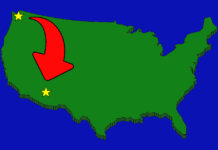
Everyone in Maricopa and Pinal County knew or had heard of “Maricopa Slim,” a.k.a. John Powers, in the early days of 1900.
Several local sources reported that the Southern Pacific Railroad hired him as a railroad detective in the beginning (death certificate states he was a deputy sheriff for the county at time of death) to control one of the major problems in Maricopa, the hobo issue. According to Donald DeHart, an early pioneer, his duty was to protect the Southern Pacific property, but he expanded this authority to include all of the Maricopa area. A jail was constructed of railroad ties, and prisoners stayed in this makeshift jail until they could be transferred to Florence.
According to Melvin Drake, another early Maricopa pioneer, his many cruel methods of enforcing the law caused some people to refer to him as the “Southern Pacific Boogie.” He always carried a wooden Billy club, which was about ten inches long and filled with lead, and he was not reluctant to use it. He also used a ball and chain to secure prisoners. Maricopa was a routine stop for all trains; while train officials got water and picked up their memos, Maricopa Slim cleared the cars of nonrevenue occupants.
However, Mary Ellen Edwards remembered one incident that happened which depicted a more caring character. Maricopa Slim lived down the road from her. She remembers the night he opened his door and found a hobo on the porch. He invited him in to dinner. At the dinner table the hobo said he would have gone on up to the junction, but he was afraid of a fellow named Maricopa Slim. As the tramp walked out the door, Maricopa Slim called out, “You’ve just eaten at Maricopa Slim’s table!”
No matter who employed John Powers, or what his disposition was, it appears he led an active and dangerous lifestyle. In January of 1913, two prisoners, who had managed to abscond with a couple of guns, shot their way out of the county jail in Florence with the threat that they were going to kill Maricopa Slim. It appears the two were still carrying a grudge with Powers for causing their imprisonment the previous year. They had broken into a Southern Pacific boxcar in Maricopa in December 1912, and the judge sentenced them to jail. No one knows how the two were able to obtain the guns, but the officers from Florence notified law officials in Phoenix and Tucson to be on the lookout for them.
However, the prisoners had neither of those towns in their sight. Maricopa was their destination and John Powers their target. Deputy Powers heard about the escape and spent the night searching the desert for the convicts. Early the next morning, he came upon the two men outside of Maricopa tending their fire and finishing their breakfast. A shootout took place with Deputy John Powers shooting one escaped prisoner and capturing the other. The dead man was J. C. Miller (a laborer) and the reclaimed prisoner was J. C. Wilson (a cowboy).
About a year after the desert shootout in November of 1914, John C. Powers encountered another challenging and heated situation. It appears there was a racial issue in progress on a train just arriving in Maricopa. The altercation involved blacks and whites, and Powers was dispatched to settle the argument. Upon his arrival, Patrick Meehan, who was employed by the Barns Circus, started to leave the train. Powers ordered him to raise his hands. Meehan refused and allegedly made some threatening motion. Powers pulled his gun and shot him four times. Falling on the ground, Meehan aimed his revolver at Powers and shot him in the abdomen. Meehan, critically wounded, was taken to the Florence Hospital. Powers died.
Note: John Powers’ death certificate states that he was born on November 5, 1883, in Texas, and his father was John F. Powers. He was 31 years old and married at the time of his death. He had been living in Arizona for the past 15 years and working in Maricopa as a deputy sheriff for the past four years. It also stated that he was last seen alive on November 4, 1914, and that he died on November 5, 1914, at 2:15 a.m. It reported his death was from a gunshot wound to the lower abdomen and listed it as homicidal. Powers was buried at Greenwood Cemetery in Phoenix on November 7, 1914.
Submitted photo
Editor’s note: Maricopa factoids are a regular feature on InMaricopa.com. They are provided by the Maricopa Historical Society, a branch of the Friends of the Maricopa Public Library. Most of the photos and information come from “Reflections of a Desert Town” by author and historical society chairperson Patricia Brock.

![‘Flying Bucket Fire’ doubles size, causes $200K in damage Tucson's Northwest Fire District crew members assist in firefighting efforts on the "Flying Bucket Fire" approximately 15 miles southwest of Maricopa on May 8, 2024. [Northwest Fire District]](https://www.inmaricopa.com/wp-content/uploads/2024/05/northwest-fire-district-050824-flying-bucket-fire-01-218x150.jpg)
![GAME OVER: The city government tried to get into gaming. It failed Maricopa Esports [Victor Moreno]](https://www.inmaricopa.com/wp-content/uploads/2024/05/263342f5-13e7-4668-838c-f574392086fb-218x150.jpg)



![Rizz party organizers say city ‘lying’ One of several flyers for a "TikTok rizz party" is taped to a door in the Maricopa Business Center along Honeycutt Road on April 23, 2024. [Monica D. Spencer]](https://www.inmaricopa.com/wp-content/uploads/2024/04/spencer-042324-tiktok-rizz-party-flyer-web-218x150.jpg)
![Province writer opens the athlete’s mind in new book Tom Schuman, a Province resident, poses with a copy of his new book, "My Wide World of Sports," outside his home on May 2, 2024. [Monica D. Spencer]](https://www.inmaricopa.com/wp-content/uploads/2024/05/spencer-050224-tom-schuman-sports-book-web-01-218x150.jpg)








![JWP to see more restrictions Monday John Wayne Parkway [Brian Petersheim Jr.]](https://www.inmaricopa.com/wp-content/uploads/2023/03/991A6929-100x70.jpg)
